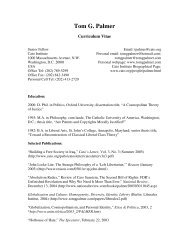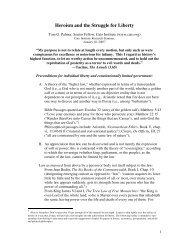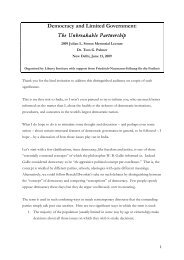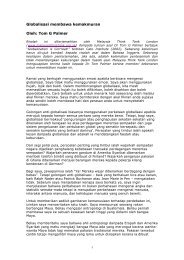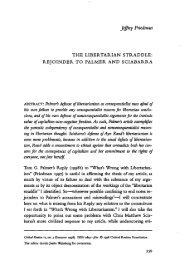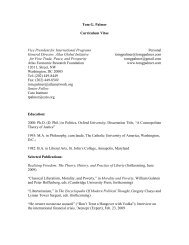Are Patents and Copyrights Morally Justified? - Tom G. Palmer
Are Patents and Copyrights Morally Justified? - Tom G. Palmer
Are Patents and Copyrights Morally Justified? - Tom G. Palmer
Create successful ePaper yourself
Turn your PDF publications into a flip-book with our unique Google optimized e-Paper software.
No. 3] <strong>Are</strong> <strong>Patents</strong> <strong>and</strong> <strong>Copyrights</strong> <strong>Morally</strong><strong>Justified</strong>? 843<br />
Arc” (as was recently done in New York), all constitute damage<br />
to the personality of the creator.<br />
In fact, the relationship between creator <strong>and</strong> creation is so<br />
intimate that when the personality of the former changes, so<br />
too can the treatment of the latter. Under article 32 of the<br />
French 1957 Law, for example: “Notwithst<strong>and</strong>ing the transfer<br />
of his right of exploitation, the author, even after the publication<br />
of his work, enjoys a right of modification or withdrawal<br />
vis-a-vis his transferee.”° 5<br />
The concept ofpersonal rights has also been extended to encompass<br />
the so-called droit tie suite, or inalienable resale royalty<br />
rights. According to this idea, a part ofFrench law’° 6 <strong>and</strong> relatively<br />
recently adopted into law by several American states, a<br />
percentage of the resale profits beyond a certain level must be<br />
given to the original creator.<br />
Objections to Personality-Based Intellectual Property Theories<br />
At theirfoundation, personality-based theories ofintellectual<br />
property suffer from a confusion about the ontological status of<br />
ideal objects <strong>and</strong> their relationship to their creators. If, as<br />
Hegel insists, “[a] person must translate his freedom into an<br />
external sphere in order to exist as Idea,” 107 this does not<br />
mean that this “translation” is constitutive of the person ‘himself,<br />
nor that the artifacts resulting from this translation become<br />
inextricably bound up with the person. This is especially<br />
obvious in the case ofsuch artifacts as a puffofsmoke, a tracing<br />
in the s<strong>and</strong>, or a knot in a piece of rope. The smoke may dissipate;<br />
the tracing may be washed away by the tide; the knot may<br />
come undone; but in none of these cases is the personality of<br />
the creator diminished,<br />
Most claims on behalf of personality-based rights are confined<br />
to “artistic” creations. Thus, Congressman Edward J.<br />
Markey (D-MA) argues that: “A work of art is not a utilitarian<br />
object, like a toaster; it is a creative work, like a song, a poem,<br />
108. C. civ. art. 548, Code penal (C.pCn.] arts. 425.429, art. 84. Damich, however,<br />
argues that, due to difficultiespresented by practical application<strong>and</strong> conflict with other<br />
rights, the right of retraction is “a ‘dead letter’ even in French law.” Damich, supra<br />
note 100, at 25.<br />
106. C. civ. art. 548, Code penal [C.pCn.] arts. 425-429 (“The authors of graphic or<br />
plastic works of arthave, notwithst<strong>and</strong>ing any transfer ofthe original work, an inalienable<br />
right to participate in the product of all sales of this work made at auction or<br />
throughthe intermediation of dealers<br />
107. G. HEGEL, .supra note 78, at 40.<br />
•t*4



